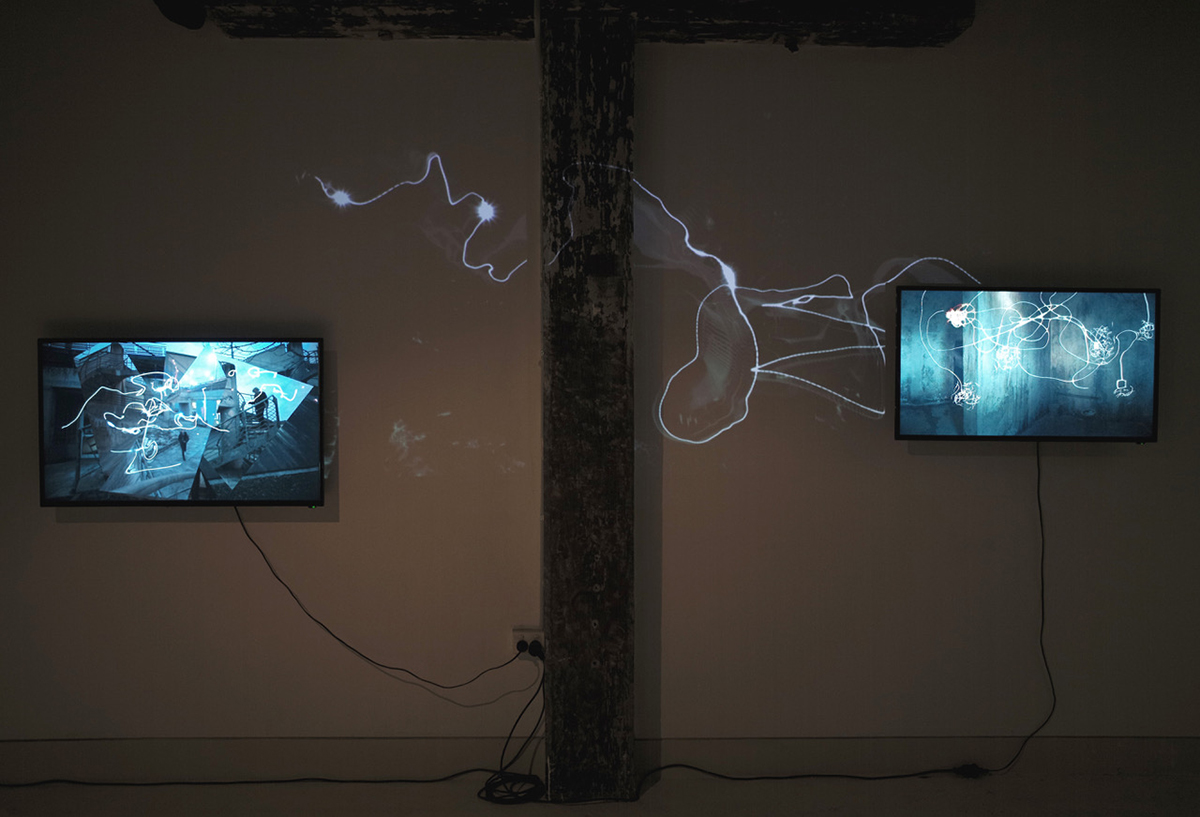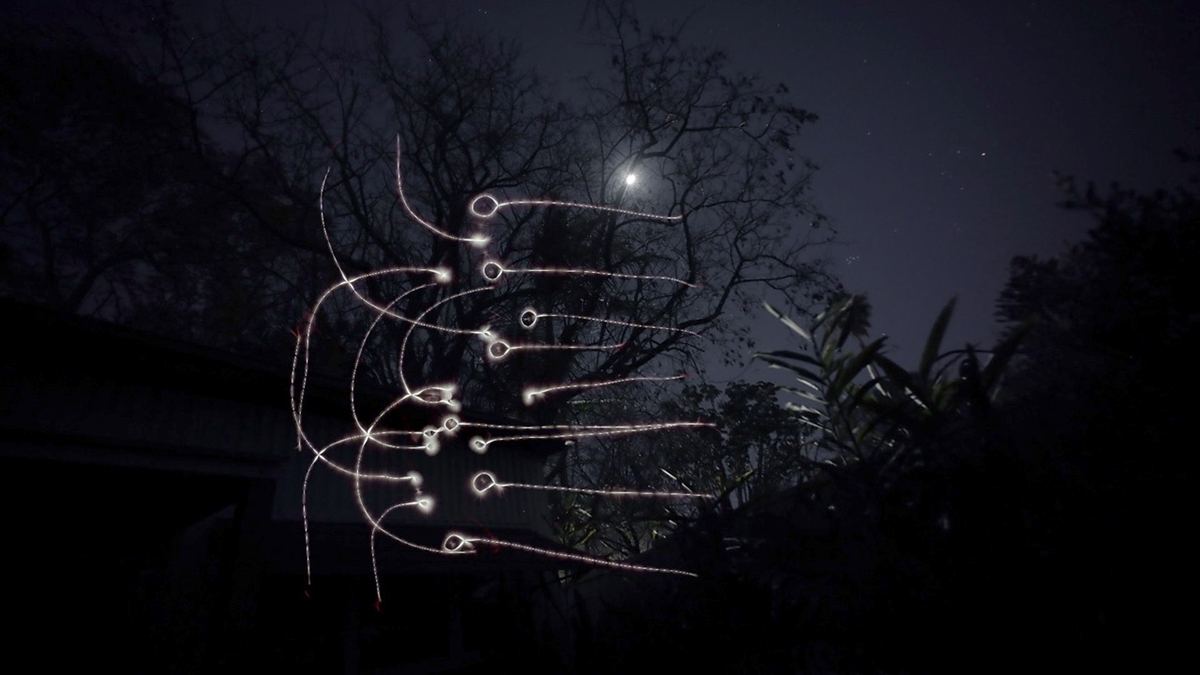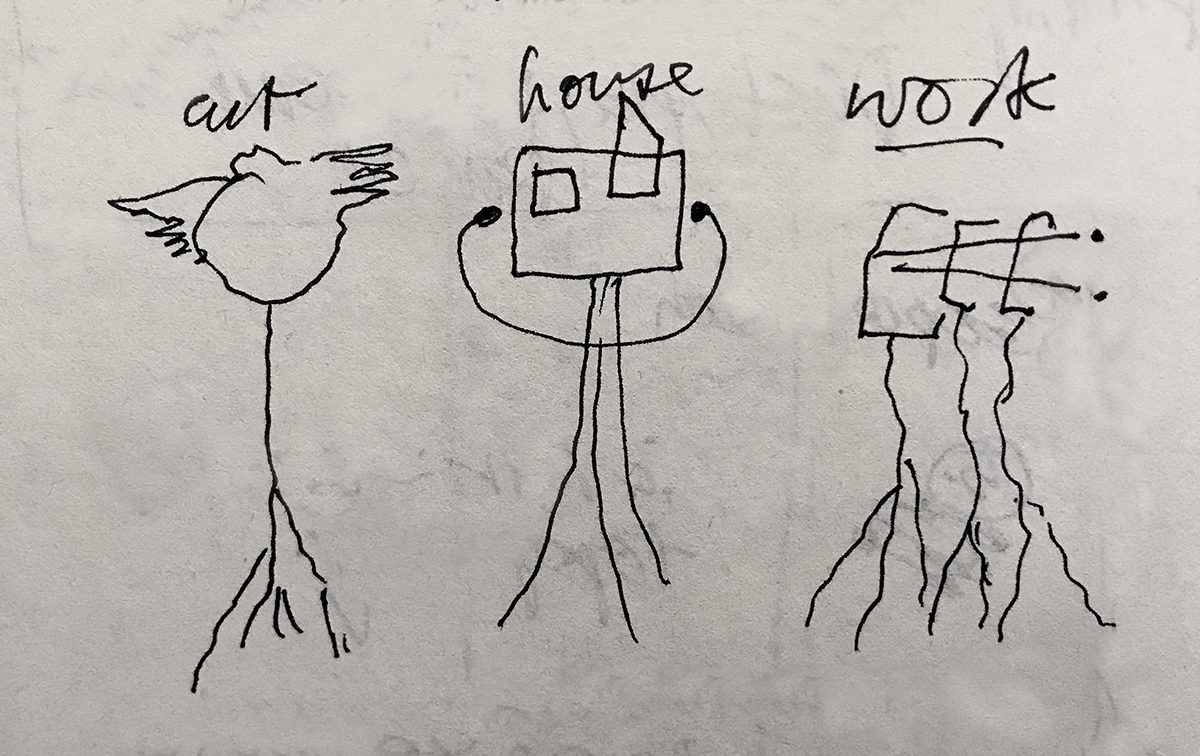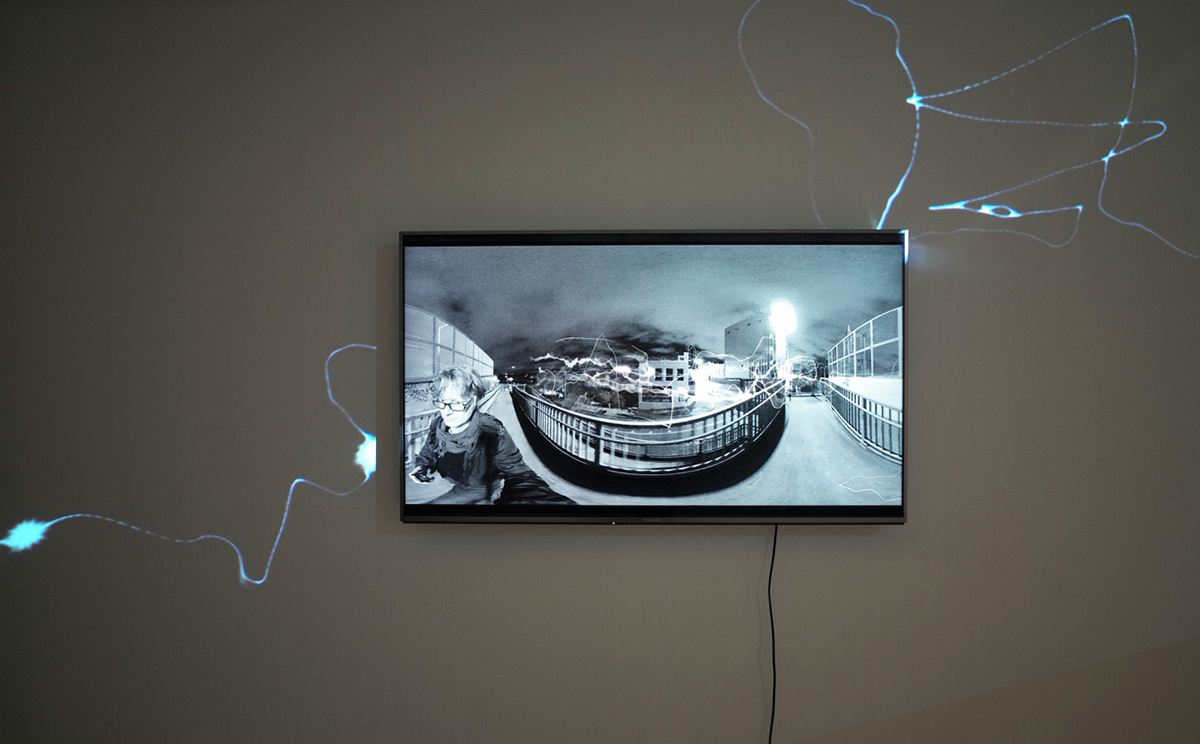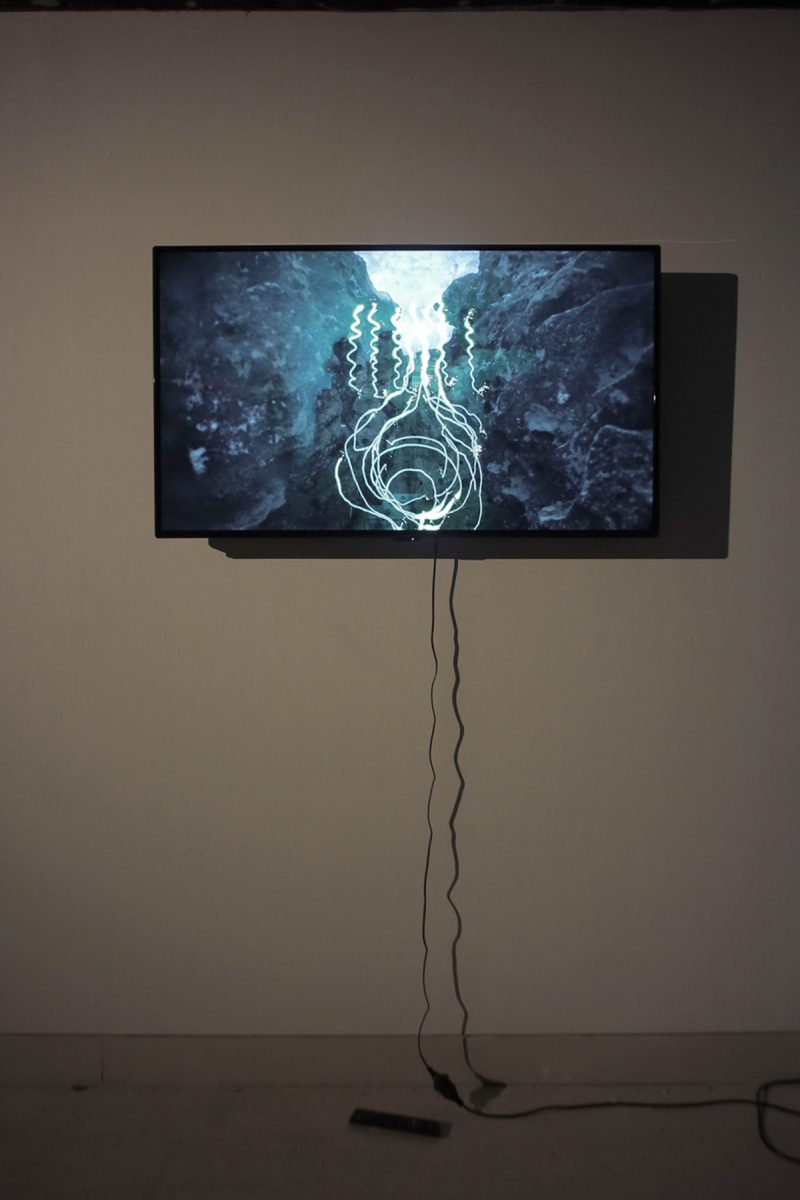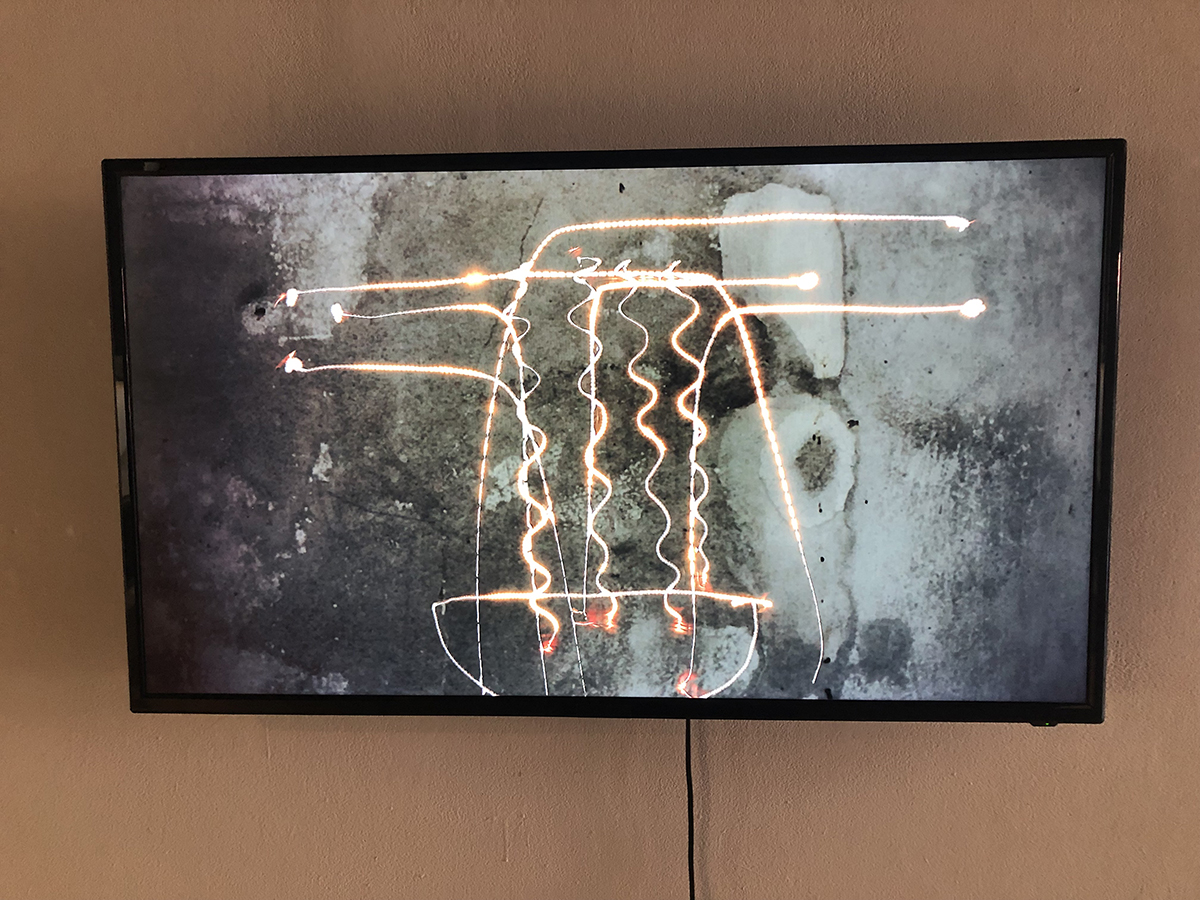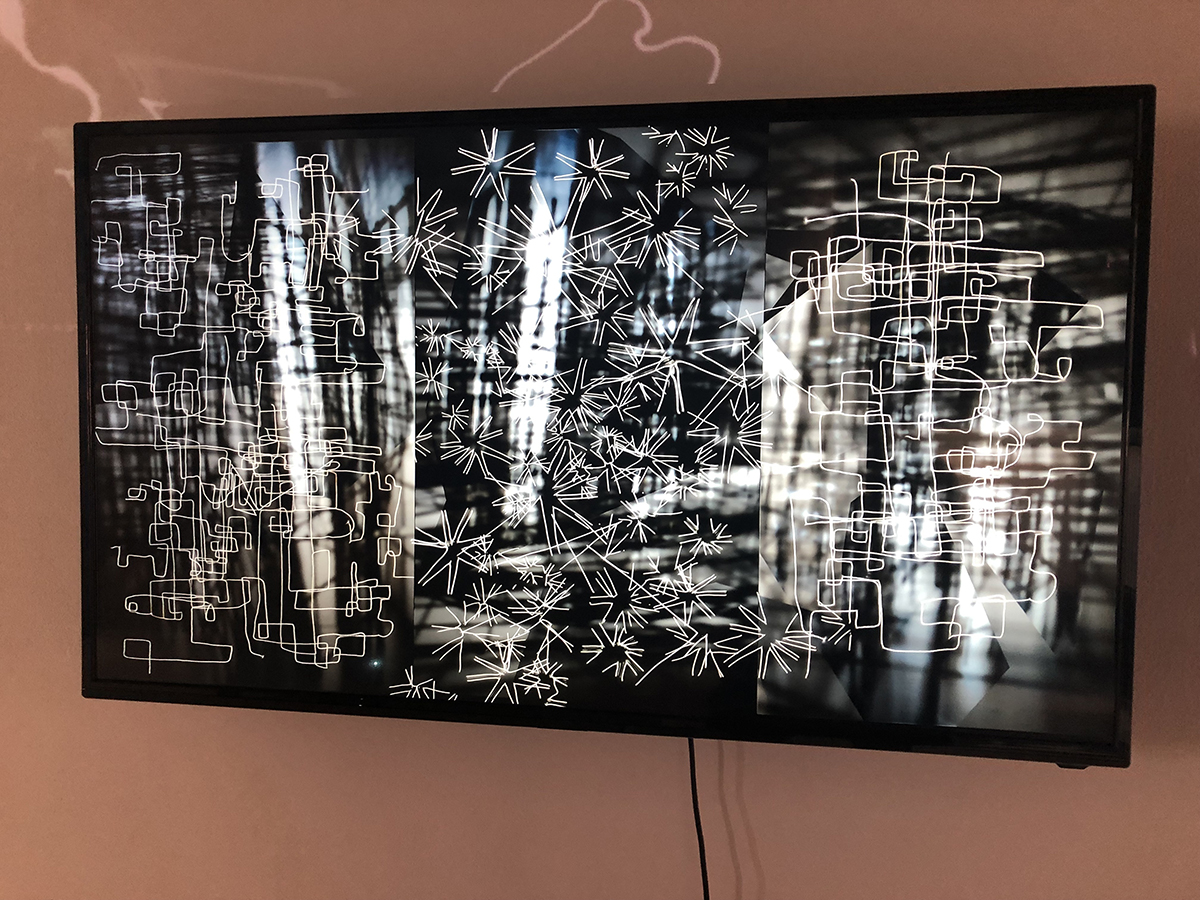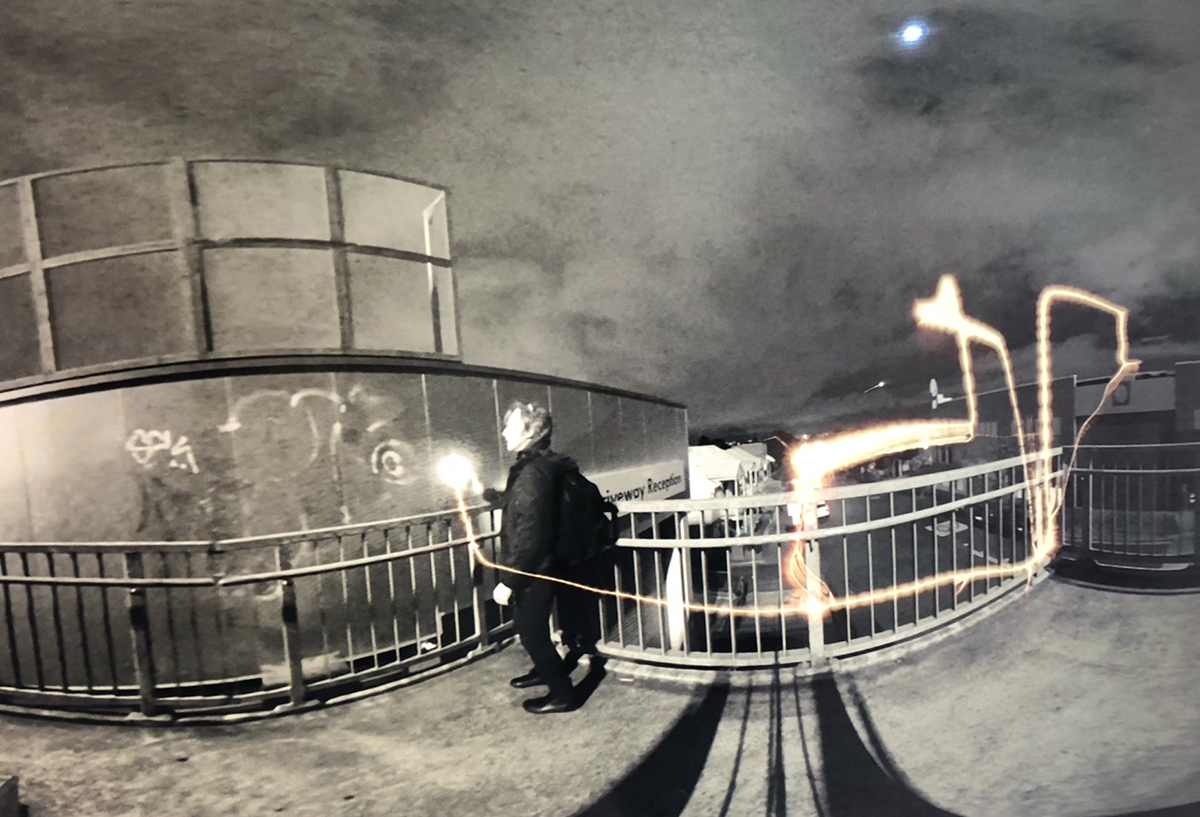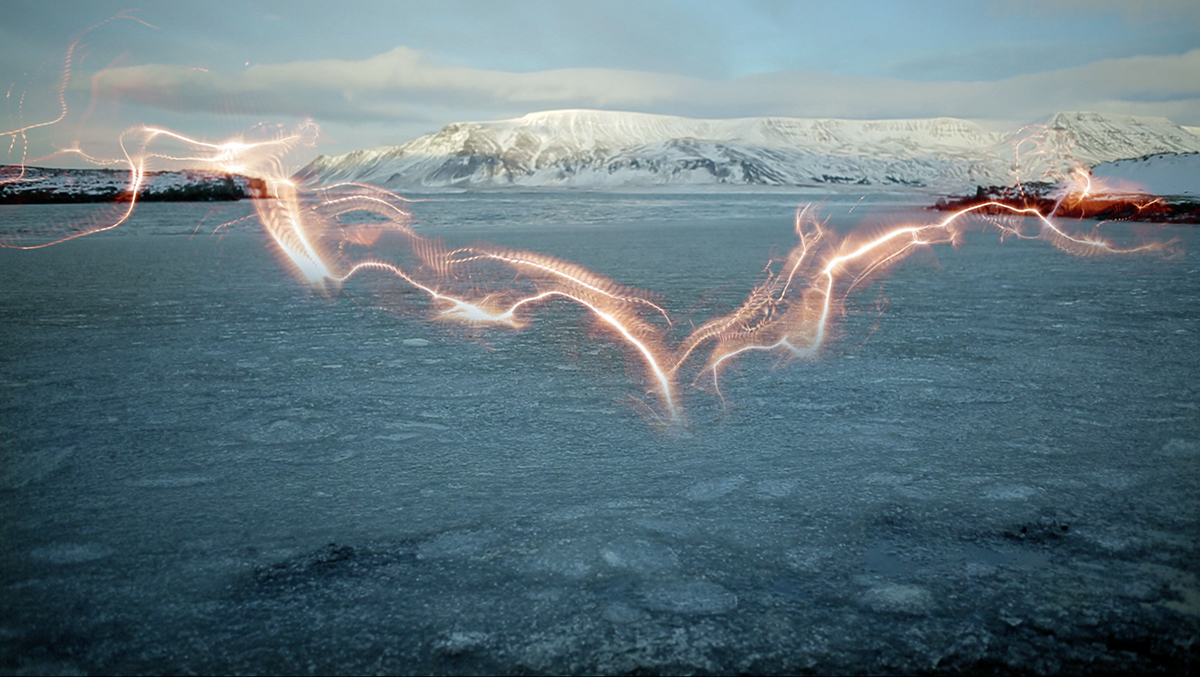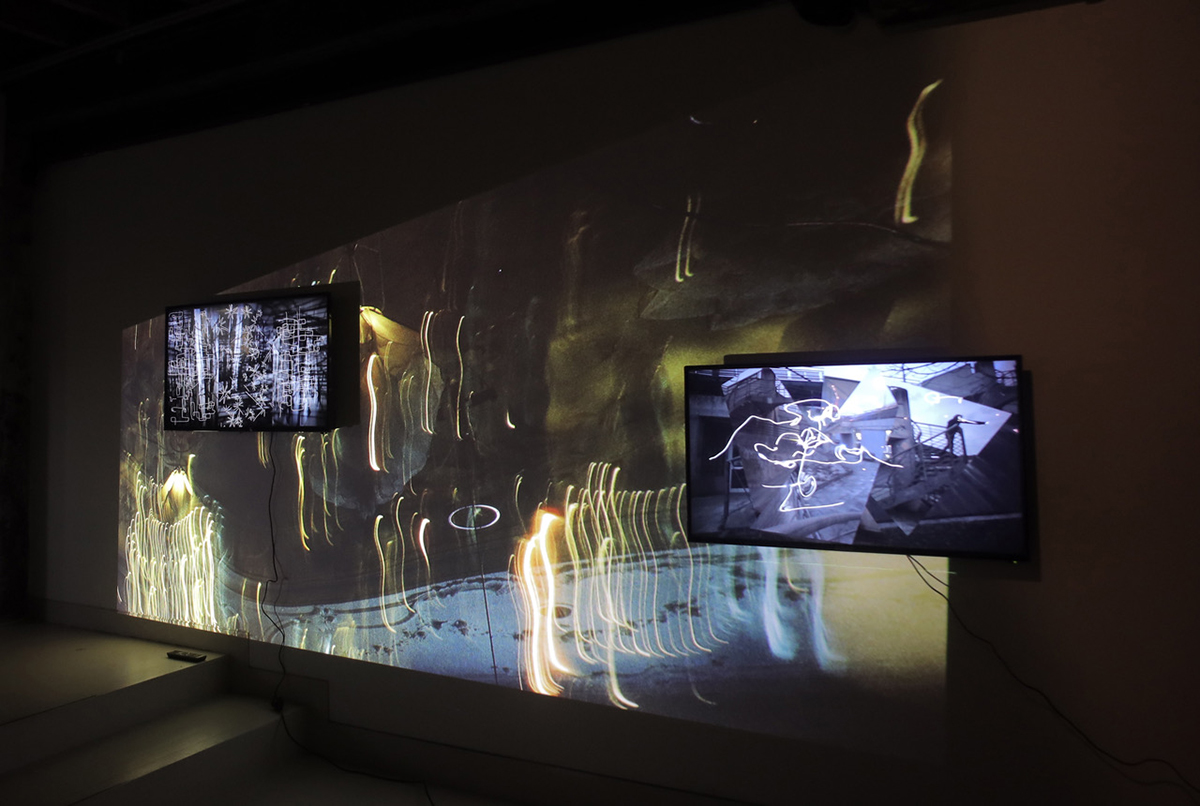
Thinking at the speed of light: the art of Sam James
With a video camera and a Mini Maglite torch as wand and abetted by collage and superimposition, Blue Mountains-based artist Sam James magically engages with thought, time, objects and spaces — Australian, Icelandic and Czech. Overlaying images with radiantly expressive unfolding lines and emergent shapes, James draws with light to engender visions which, though their titles reference the everyday, politics and philosophy, play enigmatically with perception.
James’ animations remind me of the childhood thrill of sparklers, of their explosive white radiance and even more the retinal afterglow of lines waved and slashed through night air. I envy James’ ability to preserve on video his sustained, delicate space marking, and revel in his sensual perceptual play with texture, depth of field and layered visual and sometimes aural simultaneities.
For a visual artist who much of his time works closely with dancers, musicians and contemporary performance makers as documenter and collaborator, Sam James has found through light drawing a way for himself to perform, semi-improvising, barely if at all visible, but leaving on video sustained trace lines of his presence in, as he suggests in the following interview, a transparent act of disappearance.
I visited James’ solo show Interminable Present at Sydney’s Articulate Project Space in September 2019. Very much taken with it, I interviewed the artist at my home in January this year. Added to, it via email, is an account of James’ experience of the BLIK BLIK festival of light in March this year in Pilsen in the Czech Republic. He’d been invited to make a new work onsite but Covid-19 shut down the festival. However, he completed and staged the aptly but incidentally titled Panic Embrace without a physically present audience before flying into two weeks’ quarantine in a Sydney hotel.
Let’s start with Seeing Old Friends in Sydney, to which I’m particularly attracted with its moon, silhouetted branches, reflecting leaves and, gradually emerging before them, dotted and flaring lines of light resolving into an abstraction casually juxtaposed with nature. Why the title?
The notion of ‘visiting old friends’ was a simple beginning point for the project, something I can do around this area of Sydney—Stanmore and Marrickville. All these works are site-related—this experience, this time, being here in this place. I’d never slept here in [friend artist Denis Beaubois’] back shed in Marrickville before. So, this is a new experience and it’s where I’m thinking about making the work, lying on top of a hard futon in his back shed.
Is it a window view or taken outside?
It’s me getting up at three in the morning and stepping out into the garden and looking at the sky. Denis and I have been communicating a lot in our bread-and-butter video documentation jobs, helping each other out pretty often. The curved lines here are where we intersect on email, asking each other, “Can you do this gig? Can you shoot this thing?” Then all the other lines are the few days where we actually have more sustained contact, proper instead of incidental conversations. And a tree for me is always a reference to networked consciousness, expanding limbs reaching out to make connections.
A sense of place, self and friendship?
Yes, meeting points. The lines are coming from different directions and different angles. The dots end up being part of a similar thread.
It’s quite beautiful. It’s as if you’ve traced insects flying through the night air, making patterns or, actually, a hieroglyph because the drawing movement resolves into a near formal shape.
Exactly. It is something like a hieroglyph because it’s the image of a mark. A hieroglyph means something but it’s also an illustration. Most of the works are expressions of thoughts, I suppose. If you have a thought, how do you illustrate it? You don’t have to draw a naturalistic picture; it could just be the feeling of the thought or the energy of it.
Tell me about the process? You step out of the shed and there’s the moon, the stars. What do you actually do?
[With] most of the more advanced light drawings, I first do a free sketch. The actual process of the light drawing is so chaotic, sometimes it’s good to have a plan before you start. If I want to make it look like ‘this’, I’m going to have to move like ‘this’ at ‘this’ speed.
These are three sketches I did in the Blue Mountains recently—Art, House and Work. They’re about the different ways I’ve been trying to juggle these three aspects of my life: place, self and friendship. The drawings look almost figurative and my drawing style a bit cartoon-ish. So, anything that can reduce my control over the line makes it more interesting—as if I am drawing lines in the sand on a beach at night and go back in the morning to see what the picture has become.
Was that the principal reason you began ‘blind’ video drawing, to free yourself from the constraints of formality?
Pretty much. It started from wanting to develop a way to feed back into video images because, before this, most of the time I was just recording objects and spaces and combining them. I was trying to find a way to re-enter those virtual, recorded spaces and have another effect on them, literally just wanting to be able to draw onto the image. I used to draw onto slides in the 1990s, scratching back into the photograph.
Again, the issue of reducing control.
I’ve always been interested in lack of control in the outcome. It’s a question and an answer in a way. When I see the answer I think, “Oh, that’s so much more interesting than I thought it would be.” It’s different from what I’d imagined. This makes me want to add another comment or a line or a mark or a gesture, into the image.
Where did the process of drawing with light start for you?
From doing digital motion tracking for objects. About 10 years ago I used to film images of spaces and objects and then combine them—video collage, compositing [see From the Rainforest Mind to the Desert Mind, 2012]. And I also did a lot of it with dancers, compositing them into different sensory environments or architectural spaces that seemed to suit them. [See Virginia Baxter’s review of James’ 2010 work Vivaria and the work in action on Vimeo.]
And the third element would always be, “Okay, how do I get the collaged object to not just be static? How can I make it move in a space?” I tried lots of key-frame tracking and conventional ways of animating objects, but they looked too slick and digital and I felt like it was really distracting from the photographic sense of what’s going on in the image. So, I’d draw with a torch and use the light point as the locking position for the tracking of objects. That’s how it started. I could, say, make an object move around with my human-drawn pathway rather than a digital pathway just by tracking the light point.
Then I realised the camera usually captures me drawing with the torch. I’ve never really had many photographs taken of me, so seeing myself doing this stuff, I started thinking, “Does that actually make it more interesting—to see the drawer doing the drawing?” It sort of evolved from there.
The history of video art might be crudely divided into the performative and image-making; here you’re engaging with both simultaneously.
Artists like Joan Jonas have been really inspiring for me, and Robin Rhode for his superimposition of drawings onto real environments and surfaces.
You appear in the work made on a pedestrian bridge, in Reaching Over Somewhere I Don’t Want To Go. But in others, like Visiting Old Friends in Sydney, you’re not visible, although your agency is — as a moving trace.
[See James in real time generating Reaching over… in the first few minutes of his YouTube piece, Samuel James Video Drawing projects 2015-19].The thing is, in those other works I am actually present, but I’ve just crushed the black, keyed it out, so I’m invisible. But it’s transparent. It’s good to see the action of the drawing and to get the feeling that ‘Oh, that doesn’t look like a digital i-Pad sketch.’ It feels more rustic, or like someone’s hand is actually doing it. Also, there’s blackness, darkness, the undiscovered area or the unconscious.
Waterbelly was made in Honeymoon Bay while working from 2014 on a Bundanon Trust local project, Hyperreal Tales of the Shoalhaven. I loved the rock formations on the coast. I don’t know the kind of rock, but it’s that crumbly, dark, volcanic type of matter. There’s a space between two massive bodies of rock with the water flowing in.
I was working with choreographer Philip Channels over three years on the video installation project. It being a community engagement project, I was forced to think, “How do I creatively connect with a community I don’t know; how do I impose a personal creative agenda with non-artists?” I used this ocean rock gully as a kind of environmental space for the answer and drew into it an expression of the resource we find in community. It’s pretty primal.
It’s as if the inflowing water is releasing an electrical charge between the rocks, which is very striking. The vertical lines are fairly formal, but the rest is turbulent. It has a very organic, spontaneous feel.
I’m also attracted to it because this one had a really downward energy. I’m less interested in iconographic artwork or strong metaphors. I’m always looking for the things in between obvious references and I like that downward energy. It maybe doesn’t offer much to some people but to me it’s like entropy.
I was very attracted to it. Maybe that says something about me too.
That’s the kind of thing that interests me most. It’s something that’s unusual enough to not know exactly what it is but you do get a sense of it.
Tell me about Practicing Liberty Then to be Jailed.
It came from visiting the House of Terror Museum in Budapest when I was working with Back to Back Theatre in 2017. The House of Terror is a popular museum, covering the extensive history of wars in the region. It’s different from the way Australia loves to memorialise and glorify war and focus on heroes; this place had much more the feeling of a kind of deepening of understanding of the human condition through suffering. It’s an ongoing thing that Hungary is living with. And at the time I was there, there was that massive influx of Syrian refugees. It was interesting to see a museum that was dedicated to this darker unconscious, which I think isn’t recognised as much in Australia. I ‘drew’ onto a wall in a prison cell which was retained as part of the museum when it was built.
I like the way the light brightens and flares orange and red. Strangely the line patterns in this work and some others remind me of paintings by Paul Klee.
While they’re the kinds of paintings I might aspire to, I don’t have that kind of consciousness in the moment of drawing. It’s only in accidental moments that flares happen, when the light might point slightly towards the lens and the lens might have a filter on it or it will pick up a flare, but none of that I’m conscious of at the time.
[See Practicing Liberty… unfold here on Vimeo.]
Is each work a one-off or do you try a number of ‘takes’ on location?
Most are one-offs but my choice usually sits somewhere between: the first go is the most interesting but maybe not very accurate; the second is maybe slightly less interesting but more accurate. I usually don’t go to third or fourth takes because I feel like I’m trying to control the process too much. So, it’s the first or the second which is usually chosen.
These are palpably performative works even when you’re often not visible. How did you arrive at your current approach as performer?
My work for my Master of Arts at COFA [now UNSW Art & Design] in 2012 was called Artefact Cartoons because I was only working with objects and spaces and animating them together. What I really missed was the human presence. I was used to working with performers who’d come in and make my work look fantastic. Because I’ve always worked with dancers, I’m used to the energy of dance activating background images and other objects that I’m working with. I did work a bit with dancer Victoria Hunt on light tracking, and then realised that I could do it myself.
You’ve got a camera on a tripod and you’re in front of the camera; what are you using to draw these images?
My most used tool is the Mini Maglite torch, which is only about this big [approximately 14cms long], because you can control the beam. It can be narrow or wider. My i-Phone light is also quite good. It has quite a wide throw so if you have a certain wide lens and you stop the lens down, you get quite good sun stars, eight or 10-pointed with which to trace out images.
When I was in the Czech Republic in 2018, there was a cupboard in the room where I was staying full of old, mostly worn-out art materials, but also a whole box of different kinds of torches with different-sized beams, so I used a few of them as well. And sometimes I just use the light source to reflect off objects, for example shine it onto my hand to get a smear pattern.
Compared with other works, there’s a lot going on in Detainee Hunger Protest. How did you produce so much detail? The background also seems more impressionistic.
It’s a whole lot of construction mesh I’ve double-exposed to make a more complex, lined background, but in shadow, in negative. Then the foreground is the positive white line sitting front. I’m trying to combine two levels of complexity. When I went to the Czech Republic, I was trying to be more ambitious about making more highly detailed images rather than simple gestures. I was trying to make something more complex, like a field of lines.
Quite a challenge, I imagine.
Yes. There are three panels. The first and last were lines about trying to deal with bureaucratic systems with their perpendicular, hierarchical corridors; I suppose that’s what I was thinking. Some of those lines head in a certain direction but then they have to turn back on themselves and go in the opposite direction. But they try not to deviate too much into free-form. They’re pretty much strictly limited.
And you’re doing this blind, just keeping a shape in mind all the time?
Yes. But each of those panels is a composite of probably three or four drawings. I’d draw for one to two minutes and will have filled up my screen, and then I’d do another one and then layer them together to build up a big canvas. In the central one I was trying to get really straight lines to give more of a feeling of acute fear or some kind of terror. I can do fragile, sensitive lines quite easily, but I was also trying to move towards something that was non-human, more mechanistic, more terrifying in that way.
How did you create the star shapes?
I had a camera above, filming the floor, and used my phone torch with its light on the floor facing up and sliding it in an easily controllable geometric shape, making it a more locked, inflexible line.
I’m always trying to get out of the two-dimensional or three or four-dimensional, trying to create lots of dimensions at once. In my Masters, I was trying to avoid any kind of representation of how we read the world in a bi-focal perspectival way. We assess everything from one point of view all the time when, really, every living entity has its own energy or sphere that it operates in and they’re all overlapping and intersecting. I’ve always tried to penetrate those boundaries. I can hold the torch and walk towards the camera and draw lots of lines coming towards it, but in the end you’ll only see a two-dimensional relief. You don’t always get the sense of three-dimensionality. So, by layering things up I’m trying to technically break through that limitation.
Returning to the footbridge video, you achieve a very unusual sense of depth of field. Is this work more experimental and less preconceived?
Just a pure exploration of space. I was on Parramatta Road, which is my least favourite road in Sydney but, ironically, this is where the Articulate Project Space gallery is located. This is the environment I had to work with.
The footbridge goes over to Fort Street High School but it’s one of those bridges that takes a lot more energy to get up and onto and to cross over than the few seconds to cross the road. I was thinking of it as a kind of Piranesi-style architectural space, trying to navigate while avoiding stepping onto Parramatta Road.
Piranesi with a touch of Escher; a feeling of “What is this and where is it going?”
I’m using the Go-Pro 360 camera. That’s why it has that Escher sort of warping, bubble look, turning straight lines into curves.
You included in the exhibition examples of work you did in a residency in Iceland.
I felt like I had to include something in the show from the first residency I did, which was in Iceland in 2015. I showed a half-hour film of light drawings of different spaces in and around Reykjavik. I was still experimenting a lot in those days and I was naïve, I suppose, which I miss. The hard thing for me now is dealing with knowing what the likely outcomes are, being more familiar with the results. So, I have to keep on working out ways of removing those controls.
I’ve loved doing the residencies in Europe I‘ve had since 2015, I realise, because I feel so out of my depth a lot of the time—trying to experience a new culture while knowing nothing about its history except for trivial, superficial facts; thinking about how much you can understand just by looking at monuments or reading tourist information.
You were invited to the Czech Republic to make a new work. Tell me about the festival and the work.
BLIK BLIK is a big outdoor light festival that usually attracts 30-40,000 people to Pilsen in the Czech Republic. I had done a residency there at the end of 2018, after which the festival invited me to be one of the 13 artists in the 2020 festival.
It’s a light festival in which artists are creating things like architectural fluorescent tube structures. As far as I know I’m one of the few showing video. I was planning to use wax paper clusters to project onto, to try to map the resulting images onto comet-like floating balls and have, as well, a separate monitor which showed the full picture so that the audience could see the difference between a more phenomenological experience of a work and then a more readable, cinematic view. I might still do that but it’s hard to make wax paper survive wet weather.
What attracts you to show in the Czech Republic?
I’d been to DEPO2015, run by one of the organisations that’s co-curating BLIK BLIK. One of the things I like about Czech work is that it’s very object- or sculpturally-orientated, labyrinthine and combinatorial; and artists are into collective ways of thinking about space and objects and how they work together. From a set design perspective, there’s the creation of a space with multiple things being activated. The polyvision of stage designer Josef Svoboda (1920-2002) really interests me with its multi-spatial parallelism — lots of things going on simultaneously.
What’s the way forward after BLIK BLIK? Is light drawing an area you want to keep exploring?
I think so. In a way it’s infinite in that drawing can be an exploration for your whole life. You don’t ever need to end it. Every line you draw is an unknown in a way.
There’s obviously room to move in the ways you can deploy it, in your own art and also for theatre and dance-makers. You’re creating a distinctive niche for yourself.
Yes, but I’ll still rely on working in theatre and dance. I don’t make money from the artwork and I think I have a different kind of ego from most visual artists. I find it really stressful making visual art. I’m continuing to work with writer-performer Talya Rubin. We did Bluebird Mechanicals in 2017 [read Victoria Carless’ review], and there’s a new project titled At the End of the Land for Melbourne’s Arts House. I’m also working a lot with Theatre Kantanka director Carlos Gomes on 360VR (360-degree virtual reality) projects.
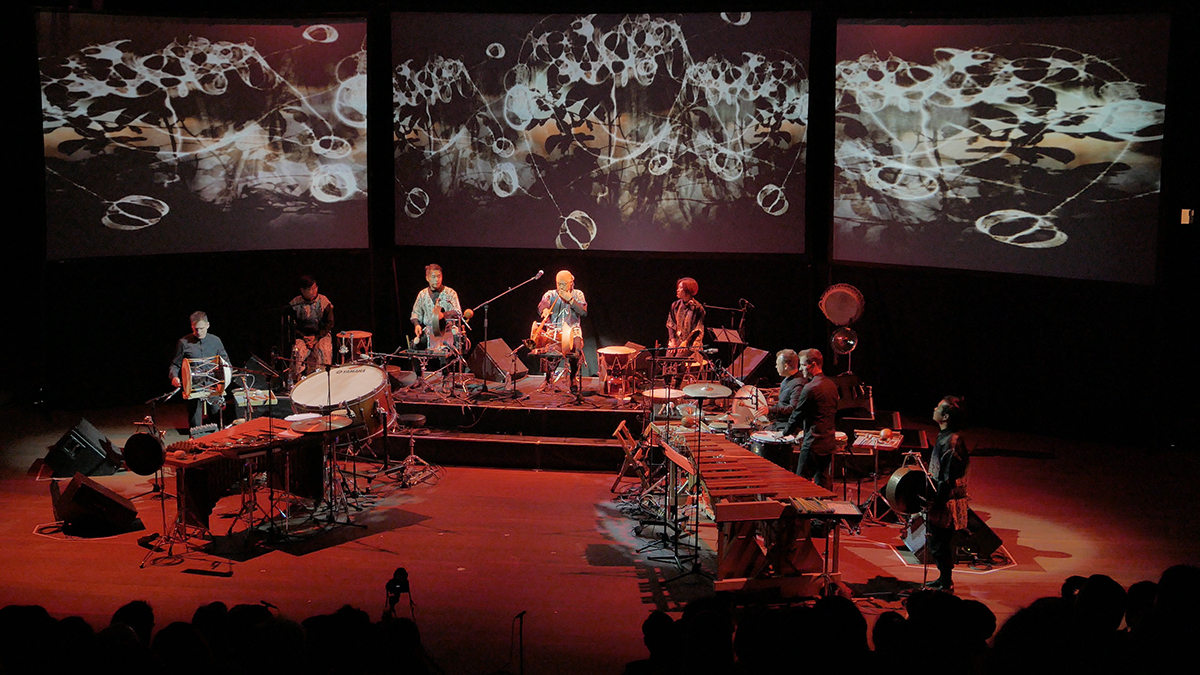
Noreum Machi and Synergy Percussion, Earth Cry, Korean Tour 2016, projections Sam James, photo Sam James
You’ve also collaborated with contemporary music groups.
I’ve made two video works using light drawing with Ensemble Offspring (2017-19) and one with Synergy Percussion in Korea (2015-2017) in collaboration with the South Korean shaman drumming group Noreum Machi [reviewed in RealTime]. Synergy had a big triptych screen for three projectors constructed for the tour. I’d never worked with musicians before. It’s been a very equal partnership: a visual medium connecting with a sound medium. Working with performance there’s a whole other dramaturgy involved. So, I’m interested in doing more collaborations.
[Sydney’s Ensemble Offspring’s Offspring Bites are commissioned video responses to works by Australian composers. For Juan Felipe Waller’s Detone/Retune, James produced in 2015 an ever mutating, image-rich contrapuntal “reaction” to the piece. The composer wrote in appreciation, “I call it a reaction, because in no moment did I give [James] an explanation of my music, and from the start he was spot on in creating a very organic imagery that complements my ideas in varied layers, adding a sense of suspense, enigma and predictability, thus enhancing the musical experience for internet audiences with crisp new qualities.”] [For Offspring Bites 2 (2019), James reacted directly, on his own terms, to the intent of Bree Van Reyk’s Light for the First Time which the composer describes as “imagin[ing] the experience of opening one’s eyes for the first time, which occurs at around 28 weeks’ gestation. The unfolding of the piece reflects a desire to be able to relive that moment endlessly, in slow motion, as if bathed in the brand-new memory of light.” James wrote of his “attempt to create pre-figurative imagery without any conception of the infinite phenomena of the material world. It is like being in a bubble of pure perception without reflexivity. To see, but without a concept of matter, the sight of a being which is yet to be born.” The fusion of Van Reyk’s transcendentally vibratory score and James’ magical evocation of emergent sight represents an exemplary interplay of music and video. On his blog, James reveals that the video was “made only with a Leica M digital camera, physical lens distortions and real time movement,” and pays tribute to the composer: “This is probably the most subtle and sensitive piece I have made, thanks to Bree.”]
Do you feel that light drawing has been singularly important in your evolution both as a solo artist and a theatrical collaborator?
Yes, it is one of the core techniques I use. So far, it’s the only way I’ve been able to think of how to break into and play within the frame of video. When I’m making video work for dance and other performance the emphasis is on making connections with the performing body. The light drawing is an action that is as close to performing as I can get. I still aspire to Joan Jonas’ approach to live drawing: it’s a way to draw video closer towards actual phenomenological experience and I think the ‘action’ of the drawing is what really matters. So, it applies as well to my collaborations with performance and its value can also enliven the static experience in gallery installations.
CODA: LIGHT DRAWING IN VR SPACE
What was your experience of BLIK BLIK?
The festival was interrupted by the Covid-19 outbreak and the lockdown after I had arrived. But I could still make the work, Panic Embrace (2020), in the festival’s workshops and present it in one of the then empty theatre spaces.
First, I was thinking about how to make the installation as immersive as it would have been in the forest in Lobeszky Park. I thought of setting the screens up in the theatre for a 360VR experience. This was a technical and conceptual jump forward, offering the possibility of more dimensional qualities through layering and collaging inside VR space as well as the potential, in the future, for making virtual installations; very appropriate in lockdown.
During this time, I was watching the 2020 Biennale of Sydney via phone videos on social media and thinking that there is a way to connect with the essence of an art work, even if it is remote. BLIK BLIK might be remounted but there are costs involved in doing a physical version again. In the meantime, Panic Embrace exists as a standalone 360VR experience best experienced on a smartphone.
Panic Embrace
Sam James’ Panic Embrace is unnervingly immersive, even on a small smartphone screen. For over five minutes turbulent images of fire and flood are projected onto a grid of suspended clothing emphatically void of bodies. The garments at one stage flare with a sense of the ghostly presence of lost wearers. At another, James’ light drawing rapidly fills the space, ambiguously suggesting art generating order and reducing panic in the face of chaos, or perhaps representing a decimating virus (see James’ own account below). Aural turbulence—flooding, thunder—is counterpointed with the eerie musicality of rattling metal, on the one hand evoking calming wind chimes, on the other the restless remnants of destroyed buildings. Whatever this push and pull, it feels akin to the “leaning in to anxiety” encouraged by psychotherapists to break panic loops. More metaphysical are the consoling words of American spiritualist Ram Dass circulating through James’ images: “Death is a ceremony in which one takes off one pair of clothes and adopts a new one. The ego sees death as suffering and the soul sees death as the awakening…of a new perception.”
On his blog, James explains that the overlaid drawings were “made with the sense of waking and sleeping brain cycles and repatriation, like a person passing through life-threatening experiences, possibly dying or being transformed and coming out the other side. They are made in the liminal state of brief hesitation, realising one’s life is at stake.”
Even though the work’s conception pre-dated the COVID-19 pandemic, James is only too aware of the palpable connection with recent and current events. He writes, “From the initial RFS command during the bushfires in NSW, ‘stay and fight or leave now’, and seeing people driving through walls of flames, bleeding into a global Coronavirus pandemic, suddenly everyone is faced with mortality, not just refugees and those fleeing terror.”
Another kind of perception is also understood by the experience Panic Embrace offers, writes James: “Using a 360-degree equirectangular canvas dissolves the singular perspective, cuts up and time-slices the space and draws light lines continuously through it, transecting our assumptions of continuity. All is fragmenting, all is simultaneous. And a lived-in process.”
For examples of James’ works in motion, see Samuel James Video Drawing projects 2015-19 on YouTube and visit the artist’s extensive archive on his website http://shimmerpixel.blogspot.com/.
–
Sam James, Interminable Present, Articulate Project Space, Sydney, 31 Aug-8 Sept, 2019;
Panic Embrace, BLIK BLIK, Pilsen, Czech Republic, March 2020, supported by Create NSW, DEPO2015 and BLIK BLIK
Top image: Sam James, Interminable Present, Articulate Project Space, photo Sam James.
–
From the RealTime Archive:
In a 2009 interview, Sam James reflects on his education (which included three and a half years in architecture school before ‘fleeing’ to visual arts) and the importance, for all of its transience, of live performance collaborations. He observed, “All of my film and performance work has been an essential philosophical decision about survival.” Following is a brief account James wrote of the phenomenological impulse that drives his work. Then, Virginia Baxter, Martin del Amo and Jodie McNeilly convey their responses to James’ deep engagement with dancers.
Keith Gallasch, Space-maker: Sam James, theatre & media designer, RealTime 91 June-July 2009
RT PROFILER 3: Under the Influence: words, pictures, sounds, RealTime 120 April-May 2014
Virginia Baxter, Tears in time, RealTime 97 June-July 2010
Martin del Amo, Anamorphic archive: the Rosie Dennis file, RealTime June 17, 2008
Jodie McNeilly, Anamorphic archive: the dancer [Martin del Amo] reconfigured, RealTime June 17, 2008


